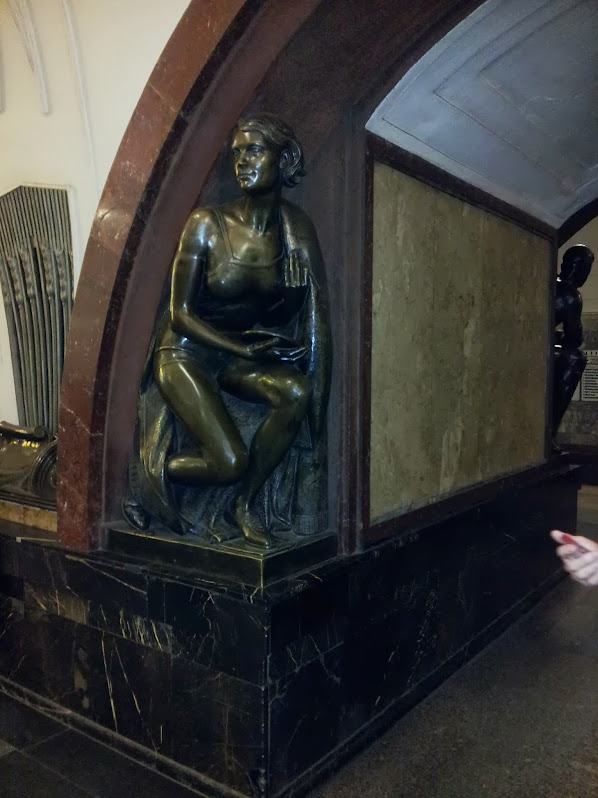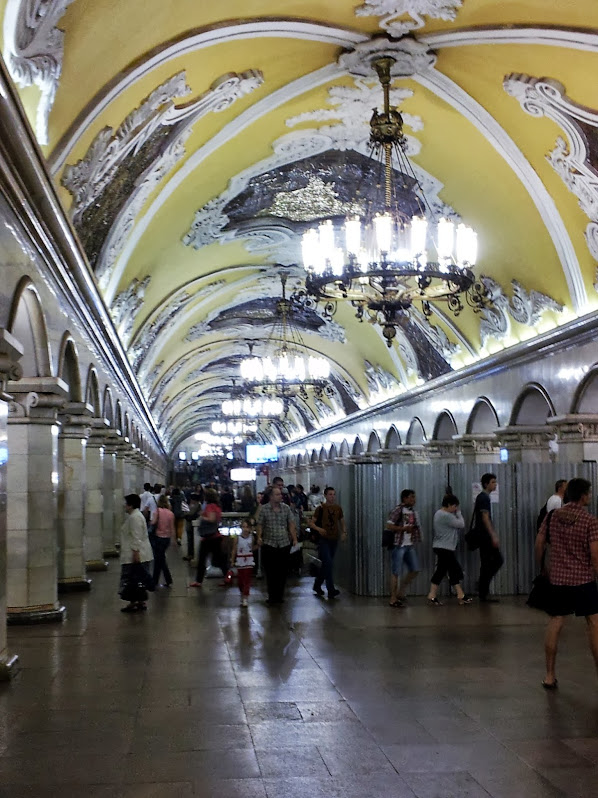Moscow
I often find, when visiting for the first time, countries to be totally different to my expectations. Russia was no exception.
Like Australia, Russia is rich in minerals and energy and there is growing general prosperity, thanks to this found, rather than made, wealth.
At times in Moscow, I thought we could have been somewhere in the US (Chicago?) particularly sitting in the MacAfee near Tverskaya St, sipping a latte, watching the similarly dressed populous pass by. Moscow has many similar buildings; including some very modern skyscrapers (but not as tall).
Part of Moscow's commercial district
Thanks to Google you can go to much of Russia in Street View.

Tverskaya St Moscow
Many streets in every major Russian city are jammed (serious traffic problems) with late model expensive European cars (Audi, BMW, Porsche and of course Mercedes; in addition to Skoda; ever-present Japanese and even some US brands). People on public transport are well dressed and many girls are, famously, very attractive.
ul Arbat - walking street - at the weekend
Some streets are eight or more lanes wide and are some are so busy that they can only be crossed using the frequent underpasses – often connected to the spectacularly ornate and grand metro system (go anywhere – right out to the suburbs - for under a dollar).
Another joke from a Russian:
| An Australian has attempted to cross the road in Moscow and is on the central lane marking, stranded. After some time a police car pulls up and the cop says: ‘are you mad – have you come here to die’. The Australian says: ‘No mate, I’ve been here since yesterdye’. |
Directly across from Lenin's tomb in Red Square there is a huge department store complex, previously the GUM State Department Store, now crammed with up-market European outlets from relatively down-market Zara to Gucci and Prada.
GUM
The square is mainly used as the venue for rock concerts.
Red Square - Lenin's Tomb is the structure beyond the tents
Capitalism triumphs. That thumping sound is Lenin turning in his grave.
Elsewhere in the city it’s the same story: up-market stores everywhere; grand hotels back in full swing. St Petersburg is the same and our friends, mentioned above, who travelled to Moscow by train from Beijing, report that major cities en route had similar stories.
My preparation for Russia came to a considerable degree from my reading of spy novels. The apparent complexities in getting a visa somewhat enforced this perception.
In reality it's not really difficult. The consulate in Sydney is pleasant and fast by comparison to say India, but you do need to be invited by a Russian tour company; and to submit an itinerary. There is a long on-line application that asks amongst other things how many countries you have visited in the past ten years and when - ridiculous. So, I was surprised to discover that no one really cared about our itinerary; or where we went; or when. Each hotel is supposed to record where you were last but even then, they seem to be happy with any kind of evidence.
During our tour of the Kremlin, with the second English speaking tour group from our cruise, that included Americans, Putin arrived. Five black cars were followed at a distance by two chase cars that did a general security circuit.
They passed directly in front of us; members of our group stepping back onto the curb to avoid them. We were not surrounded or 'covered' by gunmen.
Inside the Kremlin walls
It was not unlike the Australian PM arriving. It was a huge contrast to Obama arriving in Berlin when I was there a few weeks later; with rooftop snipers and traffic closures in half the city. Of course, this was Putin's home territory and we had all been through security.
At other times we had interactions with the troops guarding the Kremlin - when we wanted to cross areas they had closed. They were perfectly polite but firm in their refusal - typically holding their forearms crossed in a clear message that the way was blocked but generally smiling at the same time.
Craig, in particular, was a naughty boy in this regard; but there were no repercussions.
There was certainly no sense of being under surveillance (a la Syria) in the street in Moscow. Actually, you get a much stronger sense of this in London; with all those cameras; particularly if you watch Spooks on TV.
Independently we travelled by metro; walked freely past a high security government building in the back blocks; and visited the things that interested us; like the Pushkin Museum of Fine Art.
This holds classical European paintings including: Canaletto's, Rembrandts and other Dutch masters; a collection of Greek and Roman ceramic, bronze, and iron objects; Egyptian sarcophagi; a full-sized reproduction of Michelangelo's David, as well as a great number of casts of ancient Greek, Egyptian and Mesopotamian sculptures.
Rembrandt - Ahasuerus (Xerxes), Haman and Esther - Pushkin Museum
In a closed of section I could see several familiar paintings that I thought were in London; but I discovered that the museum was about to play host to an exhibition of Pre-Raphaelite art from the Tate.
Pre-Raphaelites - from Tate Modern
The Moscow Metro
As in other cities with a metro this is by far the easiest way to travel around the city. The Moscow metro was one of the great achievements of the soviet period there are 12 lines dating from 1935 to the present. The core of the system was completed during the Soviet period but new lines and extensions are added regularly as a means of relieving the traffic gridlock on the surface. The system is a conventional third track, broad gauge (5'), system. It carries around 9 million passengers each working day; rivalled in size only by those in Tokyo and Seoul.
From a tourist perspective it is worth seeing as an end in itself. During the Stalinist period the Metro symbolised Soviet achievements and many these stations are extraordinary; with very wide tunnels elaborately tiled with marble and bronze statues and decorations; chandeliers light the central halls and works of art are reproduced in the mosaic panels.
 |
 |
 |
 |
Although there is only a dozen or so really elaborate stations, the remaining stations (188 in total) are built on a grander scale than most other metros we have travelled on.
Once we moved out to the cruise ship the metro became the only practical way back into town.
Saint Basil's Cathedral Red Square
This was initially a challenge as it requires the purchase of tickets and then negotiation of the various interchanges. And unlike St Petersburg there are no names in European script - it provides a very quick lesson in Cyrillic - or matching up the words on a bilingual map. But we quickly got the hang of it; the main challenge being keeping our party, that sometimes grew to a dozen, together on the crowded trains without leaving a straggler on the platform; or a train.
Trains come about every two minutes so the trick was to wait for the next one if everyone wasn't ready or we had doubts about the direction; or line we were on.
While the ticket sales staff could be as brusque as they are anywhere, people on the trains were polite, often standing for the women in our group or moving over spontaneously to let us sit together. Uniformed officers were as helpful as they could be given the language barrier - point at where we want to go on the map.
On our side we were conscious that initially we were uncertain as to how to buy tickets and were often gazing about in the stations, getting our bearings or taking photos, while hundreds of regular commuters were moving around us in a hurry to go somewhere.
The Circus
I would not usually think of going to a circus. I remember them as a child when they would set-up on the open ground adjacent to the council yard in Pennant Hills, now covered by car sales yards, with their elephants and lions and trained horses. The trapeze artists and lion tamers were the highlights; but there was something sinister about the clowns. I always find it difficult to sympathise with Pagliacci and my daughter Julia seems to have inherited this prejudice.
There are still two great Circuses in Moscow that alternate being on tour. A visit to one was offered as an additional excursion by the tour company. We chose to organise our own visit with better seats for a fraction of the cost. To be fair the company would need to pay a guide and hire a bus for the night whereas we just needed to pay $2 for return Metro tickets.
I know that there are well regarded acrobatic circuses in Australia but don't think a circus is a real circus without trained animals. Watching humans in athletic feats can be interesting, particularly if they are cute (see the Ballet later) but there is nothing like a well-trained animal arouse one's admiration. They had chimps, goats, horses and dogs but have you ever seen trained hippos?
As in ancient Greece acrobats leapt to and from the backs of galloping horses; one, two, three... six, seven abreast. Needless to say, the sixteen or so young men on the flying trapeze were brilliant; as were the equally talented young women.
Twenty or so very stinky goats scaled boxes and scaffolds and were suitably rewarded. And so it went; with the chimps and dogs doing what they do best; apparently enjoying the applause; and their little rewards. I was reminded of the white mice in the Hitch Hiker's Guide to the Galaxy that had trained the scientists to feed them every time they did the slightest thing amusing.
But most intriguing were the hippopotamuses - said to be one of the most dangerous animals in the world. They behaved as elephants traditionally do on little stands and feet on another's back in line but they also played a game in which one climbed over the recumbent bodies of the others; and where one opened its huge mouth to fend off a beach-ball with its tusklike teeth. We took comfort in the the two rows of small children in front of us who would distract, or at least slow-down, any animal going berserk.
The clowns were non-traditional. One bore a striking resemblance to Queen Elizabeth II - staggering about with, possibly brandy laced, cups of tea. Another female, with red hair, might have been based on the immediate past Prime Minister of Australia but was rather too lanky, with advanced juggling skills, to be confused with Julia. I was most impressed by the Russian children who were delighted and engaged but also well behaved and self-contained; their parents allowing them to move about quite independently - small adults out on a special occasion.
Overall, we gave it a nine out of ten.
